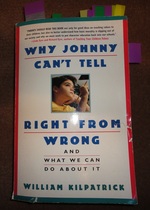Annotated Reference

Kilpatrick, W. (1993). Why Johnny can't tell right from wrong. New York, New York, USA: Touchstone
Simon & Shuster.
Summary
Professor William K. Kilpatrick professor emeritus of education at BostonCollege wrote; “Teaching right from wrong
has as much bearing on a culture's survival as teaching reading, writing, or science.” (Kilpatrick, 1993 p79).
His book goes on in great detail about how proper moral education is not being taught to our children through our culture or in our schools. He describes how good moral education was part of our culture handed down from parents to children through a culture of modeling, imitation and storytelling. He describes how this traditional method of teaching morality to
our children has been replaced by the decision-making model, values clarification (developed by Prof. Sidney Simon) or the dilemma method developed
by Kohlberg. These methods rely on the student discovering what is right and wrong and right is determined by the individual and right in some cases is
determined by how you feel.
Kilpatrick says that these methods have led to a generation of young people who cannot tell right from wrong. He believes the solution to this dilemma is for us to begin teaching character education in our schools. Character Education is the traditional method of teaching morality. It is based on the idea that there are traits of character children ought to know, that they learn these by example, and that once they know them, they need to practice them until they become second nature.
Personal Significance
I read this book during my second last course of my master’s degree. The course was EPSE 516 (Seminar in the Development and Education of Highly Able and Creative Learners) in which we were learning about students who are gifted. One of the articles we read discussed the question: Are children who are gifted more moral than children who are not gifted. This led me to reading Kilpatrick's book on “Why Johnny Can't Tell Right From Wrong”. As I was reading the book I recalled one of the most important goals that I wanted to achieve during my masters. That goal was to understand why students sometimes cause discipline problems, and how to resolve these problems so that the student, the other children in the classroom and myself and other teachers would be able to teach more effectively and the students would be able to learn more in the classroom.
I remember feeling excited when I took 2 courses a 400 and a 500 level course in ABA (applied behaviour analysis) I was told that these courses were backed by empirical evidence and held many of the answers to students who exhibited behaviour problems. After finishing the courses, I was disappointed, they did not give me many answers; yes ABA worked with elementary students and some children with autism, it helped teachers communicate with children and gave insight as to why some students are causing behaviour problems but when I worked with a student in my high school metal shop class I did not find the solutions very effective. In fact, when I contacted a Vice Principal who had experienced ABA school wide implementation he told me that, “The best thing I could do was to tell the professors who are teaching the system to stop; it does not work.” Granted I am not experienced with ABA and the previous Vice Principal I mentioned may not have been implementing ABA properly. I also have personal friends who have children with autism who did not like ABA because they felt their child was not being treated with dignity as every child should be. I believe ABA does hold many answers as to how to deal with children who are exhibiting behaviour problems or are having problems communicating.
After reading this book I felt that it gave me another tool to help students who are having problems in the school system and I feel that character education or moral education should be part of every grade just as teaching reading, writing or science. Teachers and society will also reap the
benefits of such instruction. In my many years of teaching shop class I have encountered many well behaved students but I have also had a percentage who are in need of moral or character education (poison in teachers drink, gun in school, steal from and vandalize school, bully other students) and many wanted to help but nobody in the school system seemed to know how to help them. I feel that character education would help these students live better quality lives rather than have them sent to another school or drop out.
Simon & Shuster.
Summary
Professor William K. Kilpatrick professor emeritus of education at BostonCollege wrote; “Teaching right from wrong
has as much bearing on a culture's survival as teaching reading, writing, or science.” (Kilpatrick, 1993 p79).
His book goes on in great detail about how proper moral education is not being taught to our children through our culture or in our schools. He describes how good moral education was part of our culture handed down from parents to children through a culture of modeling, imitation and storytelling. He describes how this traditional method of teaching morality to
our children has been replaced by the decision-making model, values clarification (developed by Prof. Sidney Simon) or the dilemma method developed
by Kohlberg. These methods rely on the student discovering what is right and wrong and right is determined by the individual and right in some cases is
determined by how you feel.
Kilpatrick says that these methods have led to a generation of young people who cannot tell right from wrong. He believes the solution to this dilemma is for us to begin teaching character education in our schools. Character Education is the traditional method of teaching morality. It is based on the idea that there are traits of character children ought to know, that they learn these by example, and that once they know them, they need to practice them until they become second nature.
Personal Significance
I read this book during my second last course of my master’s degree. The course was EPSE 516 (Seminar in the Development and Education of Highly Able and Creative Learners) in which we were learning about students who are gifted. One of the articles we read discussed the question: Are children who are gifted more moral than children who are not gifted. This led me to reading Kilpatrick's book on “Why Johnny Can't Tell Right From Wrong”. As I was reading the book I recalled one of the most important goals that I wanted to achieve during my masters. That goal was to understand why students sometimes cause discipline problems, and how to resolve these problems so that the student, the other children in the classroom and myself and other teachers would be able to teach more effectively and the students would be able to learn more in the classroom.
I remember feeling excited when I took 2 courses a 400 and a 500 level course in ABA (applied behaviour analysis) I was told that these courses were backed by empirical evidence and held many of the answers to students who exhibited behaviour problems. After finishing the courses, I was disappointed, they did not give me many answers; yes ABA worked with elementary students and some children with autism, it helped teachers communicate with children and gave insight as to why some students are causing behaviour problems but when I worked with a student in my high school metal shop class I did not find the solutions very effective. In fact, when I contacted a Vice Principal who had experienced ABA school wide implementation he told me that, “The best thing I could do was to tell the professors who are teaching the system to stop; it does not work.” Granted I am not experienced with ABA and the previous Vice Principal I mentioned may not have been implementing ABA properly. I also have personal friends who have children with autism who did not like ABA because they felt their child was not being treated with dignity as every child should be. I believe ABA does hold many answers as to how to deal with children who are exhibiting behaviour problems or are having problems communicating.
After reading this book I felt that it gave me another tool to help students who are having problems in the school system and I feel that character education or moral education should be part of every grade just as teaching reading, writing or science. Teachers and society will also reap the
benefits of such instruction. In my many years of teaching shop class I have encountered many well behaved students but I have also had a percentage who are in need of moral or character education (poison in teachers drink, gun in school, steal from and vandalize school, bully other students) and many wanted to help but nobody in the school system seemed to know how to help them. I feel that character education would help these students live better quality lives rather than have them sent to another school or drop out.
